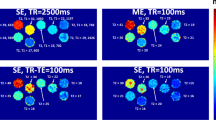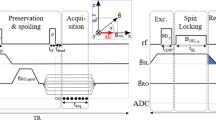Abstract
Objective
A newly adapted zoomed ultrafast low-angle RARE (U-FLARE) sequence is described for abdominal imaging applications at 11.7 Tesla and compared with the standard echo-plannar imaging (EPI) and snapshot fast low angle shot (FLASH) methods.
Materials and methods
Ultrafast EPI and snapshot-FLASH protocols were evaluated to determine relaxation times in phantoms and in the mouse kidney in vivo. Owing to their apparent shortcomings, imaging artefacts, signal-to-noise ratio (SNR), and variability in the determination of relaxation times, these methods are compared with the newly implemented zoomed U-FLARE sequence.
Results
Snapshot-FLASH has a lower SNR when compared with the zoomed U-FLARE sequence and EPI. The variability in the measurement of relaxation times is higher in the Look–Locker sequences than in inversion recovery experiments. Respectively, the average T1 and T2 values at 11.7 Tesla are as follows: kidney cortex, 1810 and 29 ms; kidney medulla, 2100 and 25 ms; subcutaneous tumour, 2365 and 28 ms.
Conclusion
This study demonstrates that the zoomed U-FLARE sequence yields single-shot single-slice images with good anatomical resolution and high SNR at 11.7 Tesla. Thus, it offers a viable alternative to standard protocols for mapping very fast parameters, such as T1 and T2, or dynamic processes in vivo at high field.




Similar content being viewed by others
References
Weiskopf N, Suckling J, Williams G, Correia MMM, Inkster B, Tait R, Ooi C, Bullmore ET, Lutti A (2013) Quantitative multi-parameter mapping of R1, PD*, MT, and R2* at 3T: a multi-center validation. Front Neurosci 7:1–11
Norris DG (1991) Ultrafast low-angle RARE: U-FLARE. Magn Reson Med 17:539–542
Haase A (1990) Snapshot FLASH MRI. Applications to T1, T2 and chemical shift imaging. Magn Reson Med 13:77–89
Mansfield P (1977) Multi-planar image formation using NMR spin echoes. J Phys C: Solid State Phys 10:L55–L58
Ljunggren S (1983) A simple graphical representation of Fourier-based imaging methods. J Magn Reson 54:338–343
Ahn CB, Kim JH, Cho ZH (1986) High-speed spiral-scan echo planar NMR imaging-1. IEEE Trans Med Imaging 5:2–7
Look DC, Locker DR (1970) Time saving in measurement of NMR and EPR relaxation times. Rev Sci Instrum 41:250–251
Henderson E, McKinnon G, Lee TY, Rutt BK (1999) A fast 3D look-locker method for volumetric T1 mapping. Magn Reson Imaging 17:1163–1171
Shin W, Gu H, Yang Y (2009) Fast high-resolution T1 mapping using inversion-recovery look-locker echo-planar imaging at steady state: optimization for accuracy and reliability. Magn Reson Med 61:899–906
Gold GE, Han E, Stainsby J, Wright G, Brittain J, Beaulieu C (2004) Musculoskeletal MRI at 3.0T: relaxation times and image contrast. AJR 183:343–351
Ding Y, Mason RP, McColl RW, Yuan Q, Hallac RR, Sims RD, Weatherall PT (2013) Simultaneous measurement of tissue oxygen level-dependent (TOLD) and blood oxygenation level-dependent (BOLD) effects in abdominal tissue oxygenation level studies. J Magn Reson Imaging 38:1230–1236
Deoni SCL (2010) Quantitative relaxometry of the brain. Top Magn Reson Imaging 21:101–113
Deichmann R, Adolf H, Nöth U, Morrissey S, Schwarzbauer C, Haase A (1995) Fast T2-mapping with snapshot flash imaging. Magn Reson Imaging 13:633–639
Hennig J, Nauerth A, Friedburg H (1986) RARE imaging: a fast imaging method for clinical MR. Magn Reson Med 3:823–833
Kara F, Chen F, Ronen I, De Groot HJM, Matysik J, Alia A (2013) In vivo measurement of transverse relaxation time in the mouse brain at 17.6 T. Magn Reson Med 70:985–993
Norris DG, Börnert P, Reese T, Leibfritz D (1992) On the application of ultra-fast RARE experiments. Magn Reson Med 27:142–164
Bovens SM, te Boekhorst BCM, den Ouden K, van de Kolk KWA, Nauerth A, Nederhoff MGJ, Pasterkamp G, ten Hove M, van Echteld CJA (2011) Evaluation of infarcted murine heart function: comparison of prospectively triggered with self-gated MRI. NMR Biomed 24:307–315
Rajendran R, Lew SK, Yong CX, Tan J, Wang DJJ, Chuang KH (2013) Quantitative mouse renal perfusion using arterial spin labeling. NMR Biomed 26:1225–1232
Bilgen M, Al-Hafez B, Berman NEJ, Festoff BW (2005) Magnetic resonance imaging of mouse spinal cord. Magn Reson Med 54:1226–1231
Stanisz G, Odrobina E, Pun J, Escaravage M, Graham S, Bronskill M, Henkelman RM (2005) T1, T2 relaxation and magnetization transfer in tissue at 3T. Magn Reson Med 54:507–512
Callot V, Duhamel G, Cozzone PJ (2007) In vivo mouse spinal cord imaging using echo-planar imaging at 11.75 T. Magn Reson Mater Phy 20:169–173
Kingsley PB, Ogg RJ, Reddick WE, Steen RG (1998) Correction of errors caused by imperfect inversion pulses in MR imaging measurement of T1 relaxation times. Magn Reson Imaging 16:1049–1055
Barral JK, Gudmundson E, Stikov N, Etezadi-Amoli M, Stolca P, Nishimura DG (2010) A robust methodology for in vivo T1 mapping. Magn Reson Med 64:1057–1067
Wang J, Mao W, Qiu M, Smith MB, Constable RT (2006) Factors influencing flip angle mapping in MRI: RF pulse shape, slice-select gradients, off-resonance excitation, and B0 inhomogeneities. Magn Reson Med 56:463–468
Rafat Zand K, Reinhold C, Haider MA, Nakai A, Rohoman L, Maheshwari S (2007) Artifacts and pitfalls in MR imaging of the pelvis. J Magn Reson Imaging 26:480–497
Busse RF, Hariharan H, Vu A, Brittain JH (2006) Fast spin echo sequences with very long echo trains: design of variable refocusing flip angle schedules and generation of clinical T2 contrast. Magn Reson Med 55:1030–1037
Han M, Chiba K, Banerjee S, Carballido-Gamio J, Krug R (2016) Variable flip angle 3D fast spin-echo sequence combined with outer volume suppression for imaging trabecular bone structure of the proximal femur. J Magn Reson Imaging 41:1300–1310
Gao Y, Chen Y, Ma D, Jiang Y, Herrmann KA, Vincent JA, Dell KM, Drumm ML, Brady-Kalnay SM, Griswold MA, Flask CA, Lu L (2015) Preclinical MR fingerprinting (MRF) at 7 T: effective quantitative imaging for rodent disease models. NMR Biomed 28:384–394
Carr HY (1958) Steady-state free precession in nuclear magnetic resonance. Phys Rev 112:1693–1701
Oppelt A, Graumann R, Barfuss H, Fischer H, Hartl W, Schajor W (1986) FISP—a new fast MRI sequence. Electromedica 54:15–18
Ma D, Gulani V, Seiberlich N, Liu K, Sunshine JL, Duerk JL, Griswold MA (2013) Magnetic resonance fingerprinting. Nature 495:187–192
Jiang Y, Ma D, Seiberlich N, Gulani V, Griswold MA (2015) MR fingerprinting using fast imaging with steady state precession (FISP) with spiral readout. Magn Reson Med 74:1621–1631
Hardy CJ, Cline HE (1989) Spatial localization in two dimensions using NMR designer pulses. J Magn Reson 82:647–654
Larkman D, Hajnal J, Herlihy A, Coutts G, Young I, Ehnholm G (2001) Use of multicoil arrays for separation of signal from multiple slices simultaneously excited. J Magn Reson Imaging 13:313–317
Norris DG, Koopmans PJ, Boyacioglu R, Barth M (2011) Power independent of number of slices (PINS) radiofrequency pulses for low-power simultaneous multislice excitation. Magn Reson Med 66:1234–1240
Norris DG, Boyacioǧlu R, Schulz J, Barth M, Koopmans PJ (2014) Application of PINS radiofrequency pulses to reduce power deposition in RARE/turbo spin echo imaging of the human head. Magn Reson Med 71:44–49
Gagoski BA, Bilgic B, Eichner C, Bhat H, Grant PE, Wald LL, Setsompop K (2015) RARE/turbo spin echo imaging with simultaneous multislice wave-CAIPI. Magn Reson Med 73:929–938
Acknowledgements
The study was partially conducted as part of the European-Union-funded SaveMe project. The overall aim of the project is the development of a modular nanosystem for use as a diagnostic and therapeutic agent targeting pancreatic adenocarcinoma.
Author information
Authors and Affiliations
Corresponding author
Ethics declarations
Conflict of interest
The authors declare that they have no conflicts of interest in relation with the manuscript submitted or any disclosures to be made. All authors have read and approved the submission of the manuscript.
Ethical approval
All animal procedures met the requirements of European Union directive 2010/63/UE in accordance with the Spanish policy for animal protection (RD53/2013) and were authorised by the Basque government (PRO-AESS-035). All procedures performed in studies involving animals were conducted in accordance with the ethical standards at CIC biomaGUNE, an institution that holds full accreditation from AAALAC.
Research involving animals
The care and use of animals followed the requirements of European Union directive 2010/63/UE in accordance with the Spanish policy for animal protection (RD53/2013), and the study was authorised by the Basque government (PRO-AE-SS-035). All procedures performed in studies involving animals were conducted in accordance with the ethical standards at CIC biomaGUNE, an institution that holds full accreditation from AAALAC.
Informed consent
For this study, formal consent is not required.
Electronic supplementary material
Below is the link to the electronic supplementary material.
Rights and permissions
About this article
Cite this article
Pastor, G., Jiménez-González, M., Plaza-García, S. et al. Fast T1 and T2 mapping methods: the zoomed U-FLARE sequence compared with EPI and snapshot-FLASH for abdominal imaging at 11.7 Tesla. Magn Reson Mater Phy 30, 299–307 (2017). https://doi.org/10.1007/s10334-016-0604-x
Received:
Revised:
Accepted:
Published:
Issue Date:
DOI: https://doi.org/10.1007/s10334-016-0604-x




